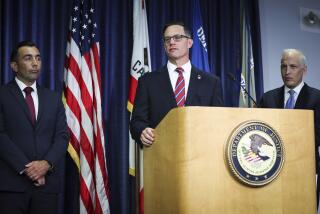On Internet, Anybody Can Be in the Spy Game
- Share via
WASHINGTON — Psst, want to know a secret?
China doesn’t need to use spies anymore to obtain precise details and sketches of America’s most modern thermonuclear weapons, ballistic missiles and reentry vehicles.
These days, anyone armed with an Internet account or a library card can get some of the same military secrets that China is accused of stealing from the Los Alamos National Laboratory in New Mexico.
That might explain why several Chinese government agencies and technical academies have tried repeatedly to access a Maryland-based online service, called USNI Military Database, that offers estimates of such classified data as the explosive yield of U.S. nuclear warheads, the accuracy of the missiles that carry them and the names of the Navy warships and the locations of U.S. Air Force strategic wings responsible for the weapons.
In this case, however, China has failed to get the goods. The reason: The privately run database costs at least $2,500 for a year’s subscription. And the information comes from combing military journals, conference reports, arms control treaties, congressional testimony and other open sources.
“They’re constantly asking for free samples,” Josh Cohen, managing editor of the database service, complained Thursday of Beijing’s nuclear Web surfers. “They could buy this if they wanted it. There’s no law against it.”
U.S. officials said that at least some, but not all, of the classified material that China is known to have obtained on U.S. warheads, missiles and nose cones is available on the Web. They won’t say precisely what, for fear of confirming the information.
“If I start to list it, I tell China what we know, and also what information they got that is accurate,” one intelligence official explained.
Even Nature of Secrets Has Been Transformed
But the explosion of information on the Internet--from high-resolution classified satellite images of Baghdad to a cutaway diagram of a W-88, America’s most sophisticated nuclear warhead--has left America’s intelligence and law enforcement agencies scrambling to keep up.
“The computer revolution, which has given society enormous benefits, has also made possible a revolution in espionage,” C. Paul Robinson, president of the Sandia National Laboratories in Albuquerque warned at a recent congressional hearing.
U.S. intelligence agencies have been forced to reevaluate and adapt the acquisition systems, analytical processes and operational doctrines that were designed during the Cold War, when paid Soviet agents used hidden cameras, invisible inks and other cloak-and-dagger means.
“This is not the Manhattan Project anymore,” said Robert S. Norris, a nuclear weapons expert with the nonprofit Natural Resources Defense Council, referring to the secret World War II effort that produced America’s first atom bomb. “The nature of what a secret is has been transformed through computers and e-mail and cyberspace and the World Wide Web.”
Of immediate concern to federal authorities is whether a former Los Alamos nuclear scientist, Wen Ho Lee, used e-mail, a removable disc or other means to pass massive amounts of top-secret nuclear weapons data to China or anyone else.
The FBI has determined that Lee electronically transferred highly classified computer files into an insecure office network for 12 years and that he accelerated the download shortly before the systems were physically separated in 1995.
Lee then tried to erase the data shortly before he was fired March 8 for security violations, FBI officials have said. He has not been charged with a crime and insists through his lawyer that he has done no wrong. But Lee has not publicly explained why he apparently put some of the nation’s most prized nuclear secrets at obvious risk.
Atty. Gen. Janet Reno defended her department’s handling of the Lee investigation at a news conference Thursday. She said she has told FBI Director Louis J. Freeh that national security is “one of our highest priorities, and we’re going to make sure that we’ve got the resources necessary to address it.”
Security Getting an Overhaul
Energy Secretary Bill Richardson last week announced an overhaul of security at the labs, including a $50-million increase in spending over two years for cyber-security.
Among the measures planned are physical and electronic barriers to prevent unauthorized downloading or removal of classified information.
But Ernest J. Moniz, the undersecretary of Energy, conceded the new effort may be too late if the nuclear secrets in the computer codes already have disappeared down a phone line.
“Technology evolved faster than cyber-security,” Moniz said.
Rep. Christopher Cox (R-Newport Beach), head of a select House committee that has investigated transfers of sensitive technology to China, said in a recent interview that the Clinton administration has allowed China to buy 600 high-performance computers since January 1996. He wants stricter limits on top-end computer exports.
“We have a very strong interest in making sure they don’t get these, because they can’t really use what they stole without these super computers,” Cox said.
That’s the other side to the computer challenge. If China really has obtained the highly technical Los Alamos “legacy codes,” as the top secret programs are known, it’s not clear they’ll be able to use them in their own nuclear weapons program, which uses technology and designs that are decades old.
“It takes many years of experience, working with experienced people, to know how to run these the right way,” said a U.S. scientist who has worked with the Los Alamos codes. “The codes are tools. I can be given a surgeon’s tools, but it doesn’t mean I can do brain surgery.”
China has used traditional spies and espionage methods at least twice since the early 1980s to obtain classified information from U.S. nuclear weapons labs.
In the first case, FBI and other officials say, a scientist at Lawrence Livermore National Laboratory near San Francisco passed papers in the early 1980s that helped China develop and test a neutron bomb. The scientist was forced to resign but was never prosecuted.
In the second, a scientist working on a classified Pentagon project may have provided China secrets in 1997 about advanced radar technology developed at Livermore. The scientist, Peter Lee, pleaded guilty last year to filing a false statement about his 1997 trip to China and divulging classified laser data to Chinese scientists in 1985.
How useful that information has been to China, or indeed how successful China’s spies really have been, is impossible to say.
More to Read
Sign up for Essential California
The most important California stories and recommendations in your inbox every morning.
You may occasionally receive promotional content from the Los Angeles Times.














